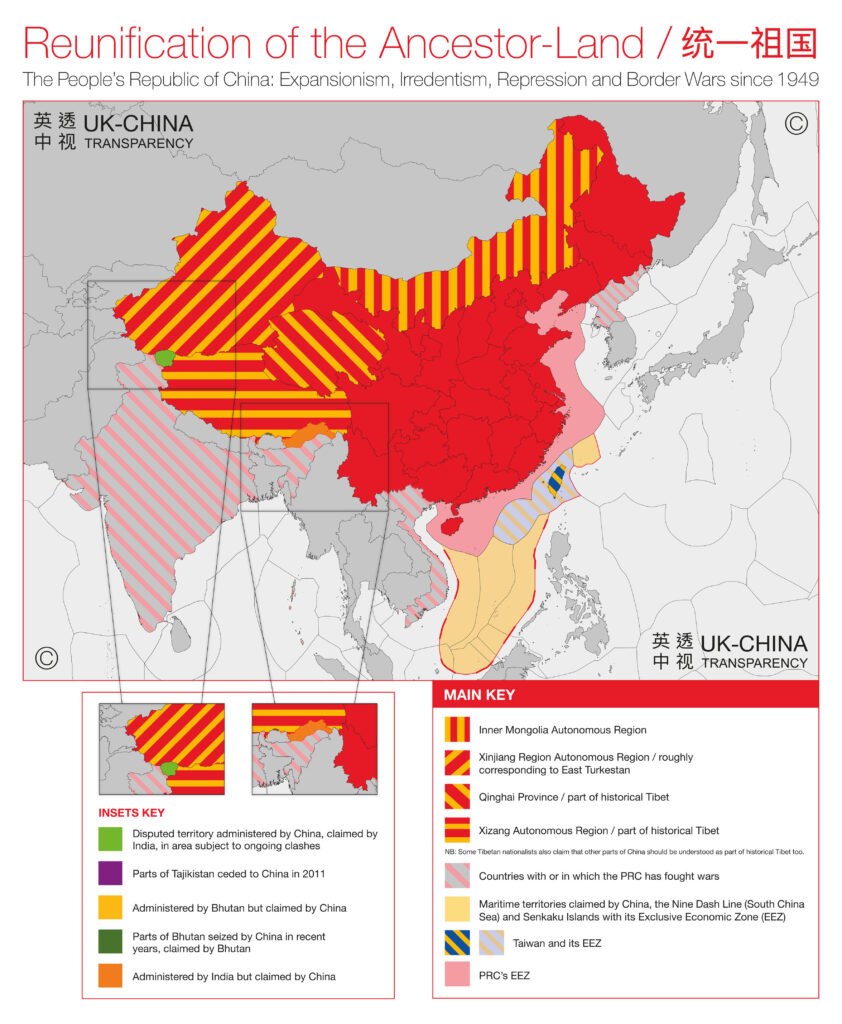Examine the speeches of Chinese Communist Party (CCP) leaders and the rhetoric of pro-CCP activists worldwide, and it will quickly become apparent that the “reunification of the ancestor-land” (统一祖国) is a central goal of the CCP. But what does it mean?
The history
The historical context is key. Historically, the Han Chinese people who constitute China’s ethnic majority, and dominate the CCP, have occupied a region sometimes referred to in English as ‘China proper’. For most of recorded history, vast swathes of what is today the People’s Republic of China (PRC) were independent of Han Chinese imperial dynastic rule. These areas had majority populations that were not Han. During the 1700s and 1800s, they were absorbed into the empire of the Qing dynasty. This dynasty itself was founded by the Manchus, a distinct non-Han ethnic group originating from a historically non-Han area, today in the north-east of the PRC.
During the “Century of Humiliation” (百年国耻, literally ‘100 Years of National Humiliation’), when foreign colonial powers undermined, infiltrated and chipped away at the Qing regime, many of these possessions were lost, or central authority over them dissolved. The setbacks, defeats, and destruction of this period were deeply etched on the memory of China’s ruling classes. A collective desire to undo and reverse China’s losses was an essential element of late- and post-Qing politics, and fuels national sentiment about “Reunification” to this day.
After the CCP’s victory in the Chinese Civil War in 1949, the CCP reconquered what had been Qing dynastic possessions in China’s west, namely Tibet (today roughly comprising the administrative regions of Qinghai and Xizang) and East Turkestan (today roughly comprising the administrative region of Xinjiang). The CCP’s rivals in the Civil War, the Kuomindang (KMT, the Chinese nationalist party), fled to Taiwan, which had also been a Qing possession before it was occupied by Japan in 1895. Meanwhile, the CCP made a claim to lands now disputed with Bhutan, India and Pakistan; to a large part of Tajikistan; and to the majority of the South China Sea and the islands and reefs contained in it. In the following decades, the CCP also fought several wars in or against neighbouring countries.
The map below illustrates these disputes. (It is a high-definition map and the finer points of it can be best examined by downloading or opening the image in a new tab, then zooming in.)

“Reunification” in practice
“Reunification”, to the CCP, means asserting PRC control over all these areas. This desire to exert control currently expresses itself in various ways, including but not limited to:
– Legalistic disputes with Japan over the Senkaku Island, and military incursions
– Maritime clashes with Philippines, Vietnamese and Malaysian vessels and the construction of reef bases and other infrastructure in the South China Sea
– Threats to absorb Taiwan by any means necessary, including conquest, and associated military incursions and drills around Taiwan; and related anti-independence and pro-reunification political warfare
– Border incursions accompanied by infrastructure construction in Bhutan, amounting to bit-part de facto annexation
– Involvement in limited violent struggles against Indian forces in the territory referred to by the CCP as ‘Aksai Chin’ and elsewhere
– Aggressive internal repression of all secessionist or independence movements, including Uyghur, Mongol, and Tibetan independence activists operating in the homelands of those peoples and elsewhere, and Hong Kong independence activists
– Promotion and justification of CCP positions on all these issues amongst various audiences, including the ethnic Chinese diaspora, international academia, politicians and publics worldwide, and diplomats.
The strategic narrative
Why “reunification”? In fact, the Chinese 统一祖国 contains no element implying ‘re-’, i.e. denoting territorial restoration. A more direct translation would be “unification”. The use of “reunification” in the English points to a key element of the CCP’s rhetoric and narrative positioning. Using historical Qing dynasty authority over disputed areas as a pretext, the CCP frames its policies as purely defensive, instead of being aggressive or expansionist. In fact, not wishing to draw attention to the expansionism of the Qing dynasty either, the CCP often frames Chinese control of areas such as Xinjiang and Tibet as having existed “since time immemorial” (自古以来). The CCP thus obscures not only its own expansionism and repression, but also the memory of expansionism by previous Chinese regimes. On this fictitious basis, the CCP can then claim that Chinese civilisation is fundamentally pacific and non-aggressive.
“Peace is in the blood of the Chinese people. Amity with neighbors, universal peace, and harmony without uniformity are values that have been cherished in the Chinese culture for millennia.”
– A typical expression of the ‘China’s peaceful rise’ narrative from Xinhua News Agency, 2023
“First, China remains unchanged in its commitment to uphold world peace. Amity with neighbors, harmony without uniformity and peace are values cherished in the Chinese culture. The Art of War, a Chinese classic, begins with this observation, “The art of war is of vital importance to the State. It is a matter of life and death, a road to either survival or ruin. Hence it demands careful study.” What it means is that every effort should be made to prevent a war and great caution must be exercised when it comes to fighting a war. For several millennia, peace has been in the blood of us Chinese and a part of our DNA.”
– Xi Jinping, in a 2017 speech at the United Nations office in Geneva
There is thus a profound connection between the phrase “reunification” and the PRC’s strategic narratives about ‘China’s peaceful rise’ and PRC non-interference.
*
In sum, the term “reunification” expresses a long-running PRC nationalist policy of expansionism, aggression and repression. The pursuit of “reunification” shapes the PRC’s diplomatic activities, military modernisation, diasporic policies, and other important CCP behaviours.